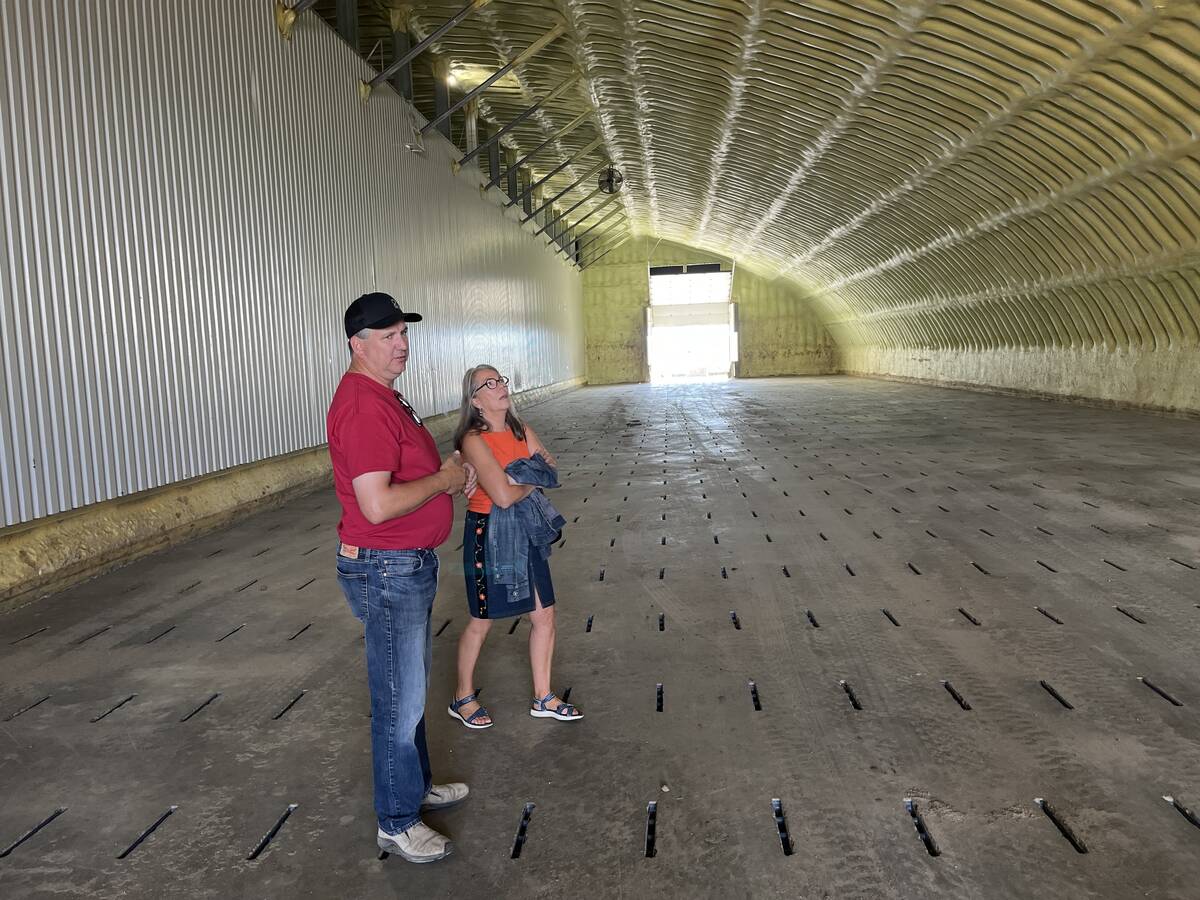ZEHNER, Sask. – Pacing anxiously and pressing her woolly sides into the far corners of the holding pen, Grandma is not impressed.
The 14-year-old Shetland ewe is long past her lambing days, but still must submit to a shearing every spring on Rose Farm northeast of Regina.
This cool spring day, she is the last ewe shorn by professional sheep shearer Lorrie Reed, who has probably cut her for most of her life.
“She just laid there,” he said. “They’re scared; they figure we’re going to kill them.”
Read Also

Potato farm requires year-round management
The most recent Open Farm Day in Alberta showcased agricultural producers across the province educating the general public about the process that is required is to get food to their table.
With the ordeal over for another season, the old girl darts to the warmth of fresh bedding and an extra feed of barley in the females’ barn.
Reed said the Shetlands, a little wilder than other sheep breeds, and rams, some as heavy as 400 pounds, represent most of the challenges and dangers in his job.
“Rams are hard to do because they’re bigger and they have an attitude.”
The young ewes, bellies distended with their soon-to-be-born lambs, quietly return to their barn, but the rams butt heads to re-establish the pecking order in their barn until they’re bloodied, bruised and breathless.
Reed keeps a small flock of sheep on his grain farm near Elrose, Sask., where he fits farming around shearing from February to July for a host of repeat customers like Margaret and Duane Rose.
The Roses hire Reed to shear their ewes at this time every year.
“It makes it easier for the lambs to find the nipples,” said Margaret.
The Roses, who raise Shetland and Katahdin sheep, have enlisted the help of friends to help them sort the wool and herd the 20 animals through the chutes.
Fueled by wine and roast beef at lunch, Margaret’s crew waited three hours for Reed’s extended cab truck and flatbed trailer to roll past the Maremma guard dog in the yard.
Reed and his two fellow shearers were delayed by snow and ice-covered roads in central Saskatchewan and a large sheep flock to shear on a neighbouring farm.
Duane said it’s worth the wait for a professional team.
“We can’t do it good enough. We don’t have the equipment, skills and energy,” he said.
Reed agreed, saying shearers avoid short cuts and limit stress on the animals by working quickly.
“It looks easy when you’re watching it but it’s because we’ve been doing it a long time,” he said.
The world record time for shearing an animal is 17 seconds, he said.
Reed, who shears about 20 to 25 sheep an hour, charges $5 a head for small flocks and $3 a head for herds of 150 or more.
Within a half hour, the crew had set up a swing gate and fence to contain the animals awaiting shearing and laid three plywood sheets over the concrete floor for a non-slip shearing surface. That also provides a softer landing for any razors that might drop.
Sheep bleat and fences clang as Reed oils his shears and hangs electrical cord for the shearing equipment from the rafters to keep it off the floor.
The crew dresses in multiple layers topped with coveralls that bear the blood stains of their daily work. Nicks to the wriggling sheep and occasionally to the shearer are not uncommon, so Reed wears a glove in his non-shearing hand to protect it from the razor.
He selects an animal from the holding pen by the head and horns and drags it backward through the gate, where the legs trip over a raised lip on the bottom of the gate. That allows the shearer to place the animal on its behind for shearing, the most efficient position.
“Ninety-five percent of them will just sit there; for the other five percent you just hold on,” he said.
Reed’s routine remains constant, starting with his shearing tool on his right and shearing the belly, first hip and neck before turning to face the machine to do the rest of the neck, shoulder and opposite hip.
The shearers always work on the ewes first.
The wool falls to the floor where Margaret gets some help from friend Dora Mushka to bring it to a large chicken wire-topped table for sorting. Dora’s husband Gerald helps Duane round up and pen the animals awaiting shearing as a black and white cat watches wide-eyed from a high barn shelf.
They will take off any dirty sections, particularly from the rear of the animal, said Margaret. Small bits fall beneath the table, where Margaret will look at them again later for salvageable bits.
The waste wool will be used as mulch on the fields.
Wet wool does not store well, so Reed advises producers to keep their animals indoors before shearing. Dirty, sandy or dense wool is also troublesome because it dulls his shears.
He insists on working inside to avoid biting winter winds and searing summer heat.
Reed also asks farmers to take their animals off feed in advance of the shearing because “their bellies don’t bend well when they’re full.”
Largely self-taught, Reed started shearing in 1988 and keeps abreast of the latest information through trade newsletters and by attending seminars.
Each farm he travels to is an education, he said, noting how he meets people and sees different operations. Sheep herds are scattered across Saskatchewan, with the largest numbers in the southwest.
His long days on the road start early at 6:30 a.m. with a high fat breakfast, often bacon and eggs, usually provided by the farm where he overnights.
“A sheep shearer will burn 5,000 calories in a day, as much as an Olympic athlete,” said the tall, lean Reed.
The men limber up with exercises, wear a felt pad on the lower back to keep it from tightening up and always keep water nearby.
A Jolly Jumper-like harness can be used to take the pressure off the back during shearing, but Reed finds it just gets in the way.
As they bend over the last of four rams on the Rose Farm this day, the sun sits just above the horizon. Down the slick spring grid road, one more job still awaits Reed’s crew.
There, another 40 sheep will have to be sheared before the men can enjoy a hot supper and a good night’s sleep.
















